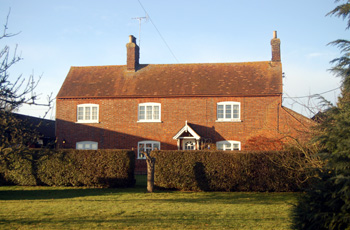Hill Farm Stanbridge

19 Tilsworth Road December 2008
Hill Farmhouse, 19 Tilsworth Road, was listed by the former Department of Environment as Grade II, of special interest. The building dates from the 18th century and is built of brick, red stretchers and grey headers. The building has two storeys and an old clay tile roof.
In 1909 Christopher Buckmaster owned Hill Farm. In this year he became involved in a dispute with the outgoing tenant George William Olney which required to be settled by arbitration [BML10/46/32].
It is not widely remembered today but in 1917 Britain was facing starvation. The unrestricted German U-Boat campaign was destroying large numbers of ships carrying food across the Atlantic. As something of a panic measure it was decided to plough up old grassland in an effort to plant more arable crops to feed the country. County War Agricultural Executive Committees were given the task of finding suitable land. Usually the farmer objected, for the good reason that he knew that any crop obtained would be poor and/or uneconomic. Frederick and Thomas Yirrell at Hill Farm were ordered to plough up some of their grassland [WW1/AC/OP1/2] and duly objected for just these reasons. Eventually, the convoy system was introduced and matters eased enough to obviate the need to plough up meadow and pasture.
The Rating and Valuation Act 1925 ordered every piece of land and building in the country to be assessed to determine the rates to be paid on it. Stanbridge was assessed in 1927 and the valuer visiting Hill Farm [DV1/H28/16] noted that it was owned by the Misses Buckmaster and occupied by Frederick Yirrell who paid £145 per annum rent, which had been fixed in 1909. The farm contained 124 acres and the valuer commented: "Buildings good, some new, house rambling" "Nice house and good homestead"
The brick and slate farmhouse comprised three reception rooms, a kitchen, dairy and pantry, with three bedrooms and a boxroom on the first floor. the homestead comprised:
- West Block: a brick, wood and corrugated iron four bay open cart shed; a trap house; two loose boxes; a piggery; a loose box; a stable for four; a cow house for three beasts and a feeding hovel;
- North Block: a brick, wood and corrugated iron barn;
- East Block: a weather boarded and corrugated iron lean-to; a brick, wood and corrugated iron barn used as a feeding hovel; three brick and slate loose boxes and a large loose box and a granary;
In the meadow: a large brick, wood and thatch barn and feeding hovel; a brick and corrugated iron four bay open implement shed and a shed for an elevator.